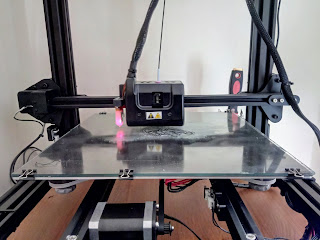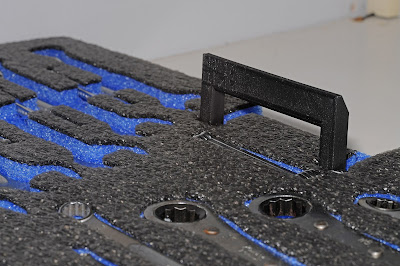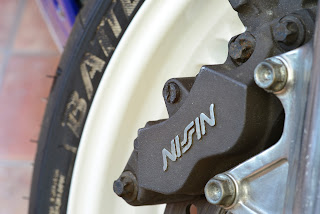What are my choices 3D printing?
Much like other manufacturers, we will chose a suitable material and build parameters to suit the needs of any product, but unlike them; we also give you the choice to make your own informed decisions.
The design in any given product takes the following requirements into account:
- Strength
- Hardness
- Ductility
- Malleability
- Elasticity
- Temperature resistance
- Chemical compatibility
- Weight
- Aesthetics
- Transfer of loads
....and the list goes on.
We pick a balance with all of these needs to best suit the majority of people. You may have a stronger need in one direction than most people have and that is where you can make an informed choice to go with something other than what we have suggested.
Let us break down some of the things that you can alter to best suit your own needs.
Material
There is no one material which will best suit all requirements. You will now find a mind boggling number of materials out there so picking the right one can be tough. Here is a little information to help you understand the properties of some common ones and why you might want to choose them.
You can click on any of the hyperlinked headings which will take you to the colour range supplied by Prusa, our main filament supplier.
PLA
Starting from the most commonly used plastic filament; polylactic acid is cheap, biodegradable and easy to print with giving an attractive and surprisingly strong finished product. It has poor high temperature performance (temperatures as low as the inside a car in summer can deform a part) however and being biodegradable, it will not last as well. This material is good for indoor ornaments, unstressed parts and mock ups, however it has a tendency to shrink so results may be misleading. Being a popular material it comes in a huge variety of colours and blends with metallic and woods.
PET
You will see that we suggest PETg a lot. It is easy to print with, doesn't react with water, good thermal resistance, 100% recyclable and strong. PETg has added glycerol which adds a bit of elasticity to the PET which makes it less likely to shatter, another added bonus. Traditionally used in the food industry for things like disposable plastic bottles, it is chemical resistant and food safe too. It comes in a wide variety of colours in both opaque and translucent.
Carbon reinforced PETg
As above but with the added benefit of carbon fibres in the plastic. It is stronger and lighter than the equivalent PETg but otherwise shares all of the same benefits. The finish is a mat grey. The down side will not shock you, it is comparatively more expensive and increased hardness means more brittle in theory.
ColorFabb XT
Similar in many way to PETg with heat resistance of 80°C. It costs a bit more, doesn't appear to be recyclable and colours are limited but still a worth while option.
XT CF20
as the name suggests; it is 20% carbon fibre blended with ColorFabb XT. It is heat resistant up to 80°C and light weight. It is worth noting that all of these carbon enforced polymers are not continuous weave giving an attractive matt grey finish.
CPE
High tensile strength, layer adhesion chemical resistance, impact resistance and resists warping up to 80°C. It's like PET but better. All at the cost of, well, cost.
PC blend
If you wish for a stronger material still without going to ABS then this might be what you were looking for. With better strength and thermal resistance now up to 113°C, it is a strong contender with only the higher price and hygroscopic nature letting it down (the Prusa PC blend we use has better moisture resistance to standard PC but is still noteworthy). It is however unsuitable for large prints. As this is a less common material it comes in less colour options.
ASA
ASA is a tough material which has generally replaced ABS in 3D printing. Combining its strength and elasticity it is shock resistant like ABS but is easier to work with and less toxic.
ASA is still a Styrene based product which produces dangerous gases during manufacture and require an enclosure for best results. As a result we do not generally use it unless specifically needed. ASA's greatest floor over ABS is it is Hygroscopic.
Nylon
Strong precise and self lubricating. You will find Nylon used a lot in things like gears. Not an especially commonly used material but an option non the less for specialist needs.
TPU/TPE
If flexible is what you need, this is what you want to use. We will probably make the call on this one before you do unless you really want some wabbly parts.
Resin
If you intend to produce a wax lost resin casting, this is the stuff you want your part made with. Otherwise it is mostly useless for what we do.
The following are still options but not ones we generally suggest unless you really must have that material.
ABS
Abs is a tough material used in the automotive industry which is able to comfortably withstand temperatures of -20ºC to 80ºC. Combining its strength and elasticity it is shock resistant and even when damaged it can be plastic welded.
ABS is a Styrene based product which produces dangerous gases during manufacture and require an enclosure for best results. As a result we do not generally use these products.
Optionally, can be bought with carbon or Kevlar reinforcement.
PP
Polypropylene is strong, shock resistant and hard wearing which is why it is pretty common in wider industry. It is not particularly resistant to heat however and UV rays can also damage it which makes it unsuitable for many of the products we produce.
This is not an exhaustive list. There are many more materials are out there and if you are after something in particular, you probably know about it already so just let us know.
We stock commonly used materials but are happy to buy in specialists colours or materials at cost.
Slicing
slicing is something carried out by software to take a 3D image and convert it into a plot that a 3D printer can follow.
Your personal needs may require us to do something different to what we would usually do. Here are some things you can change and why:
Layer thickness
Thinner layers will give more detail and gradual curves in the vertical axis at the cost of more time printing. The thickest layer we can currently print at is 0.4mm but we tend to print below 0.2mm for best results for all but the roughest of drafts. If surface finish is prime to you, you may want to request a slower printing speed too. If speed is prime then we can go thicker still with different nozzles.
Number of surface/perimeter layers
More layers basically means more hard at the cost of weight, material use and loss of flexibility. Thicker layers also gives you rework room where you might want to machine a surface or enlarge a hole.
Infill
Between the upper and lower surface in all but the thinnest of parts will be an infill. This is given by a percentage and will be an ever denser pattern of plastic infill. More infill adds support to the walls. It is worth noting however that a large amount of infill would be required to have the same benefit as a slightly thicker wall thickness. Obviously more infill = more weight and cost. If you wish to drill your own holes or need very high strength in a product then you are likely going to want 100% infill.
Orientation
A less obvious decision but one that makes more sense if you imagine a 3D printed object more like wood. The layers are strongest along their length so depending on loading you may want an item oriented a certain way on the printer bed depending on the direction of loads.
Fasteners
More complex parts may require the use of fasteners to attach parts together or to a larger assembly.
We offer a number of solutions from simply designing in reinforced holes to including metal threads either with metal inserts melted into the part or captive nuts added during the printing process.
Design change
If you have a special need from a product you can ask for the design to be altered. This is a fairly time consuming process and will come with the associated costs in both money and time.
One of the big benefits of 3D design is its adaptability and flexibility.
Post processing
As a rule that will be to remove support structures, imperfections and to generally inspect the part for correct dimensions and for errors in printing before shipping.
You can request more however.
We can perform the following post processes:
- chemically smoothing
- sanding
- engraving
- plastic welding
- painting
If there is anything you are unsure of or would like to request then please do not hesitate to get in contact through our Facebook or Google pages.
This list is not exhaustive but merely a guide to assist your decision making.









Comments
Post a Comment